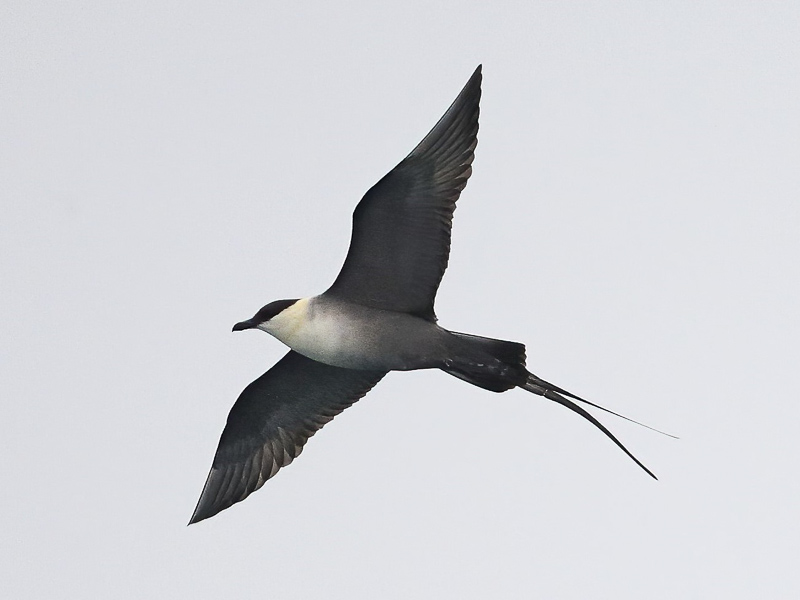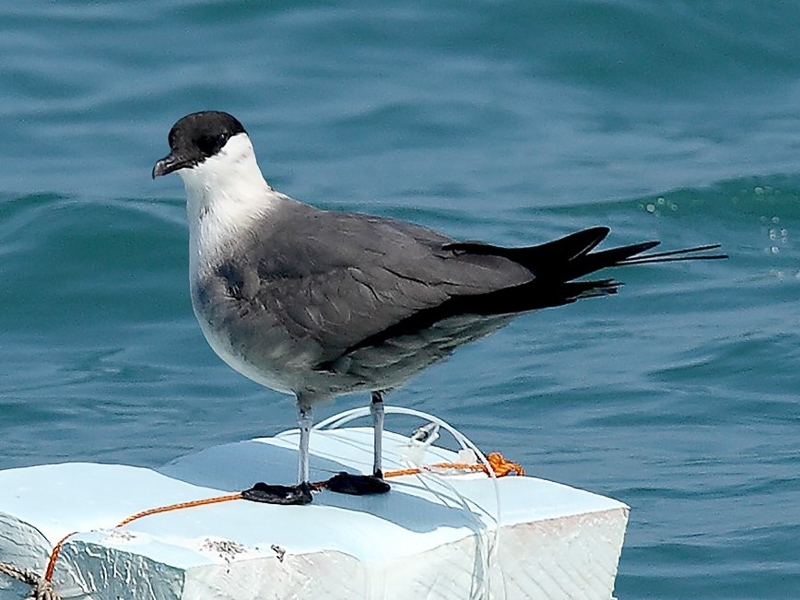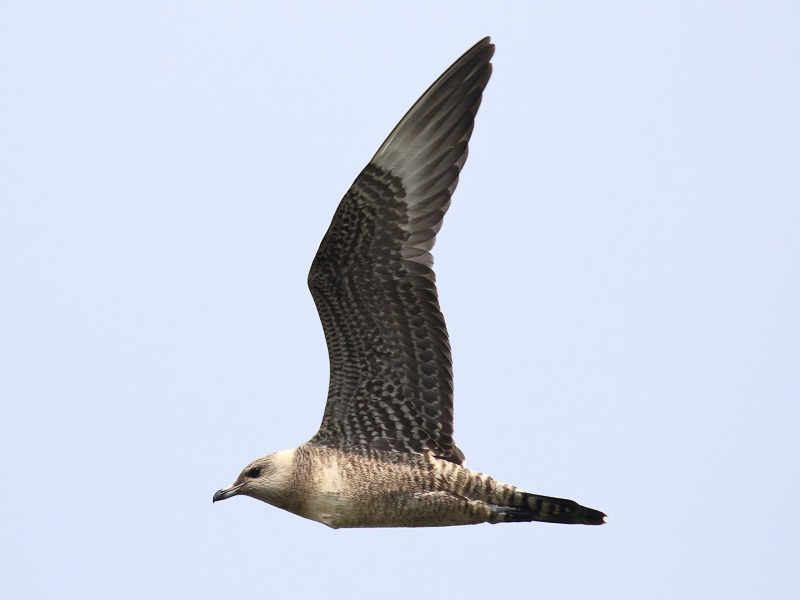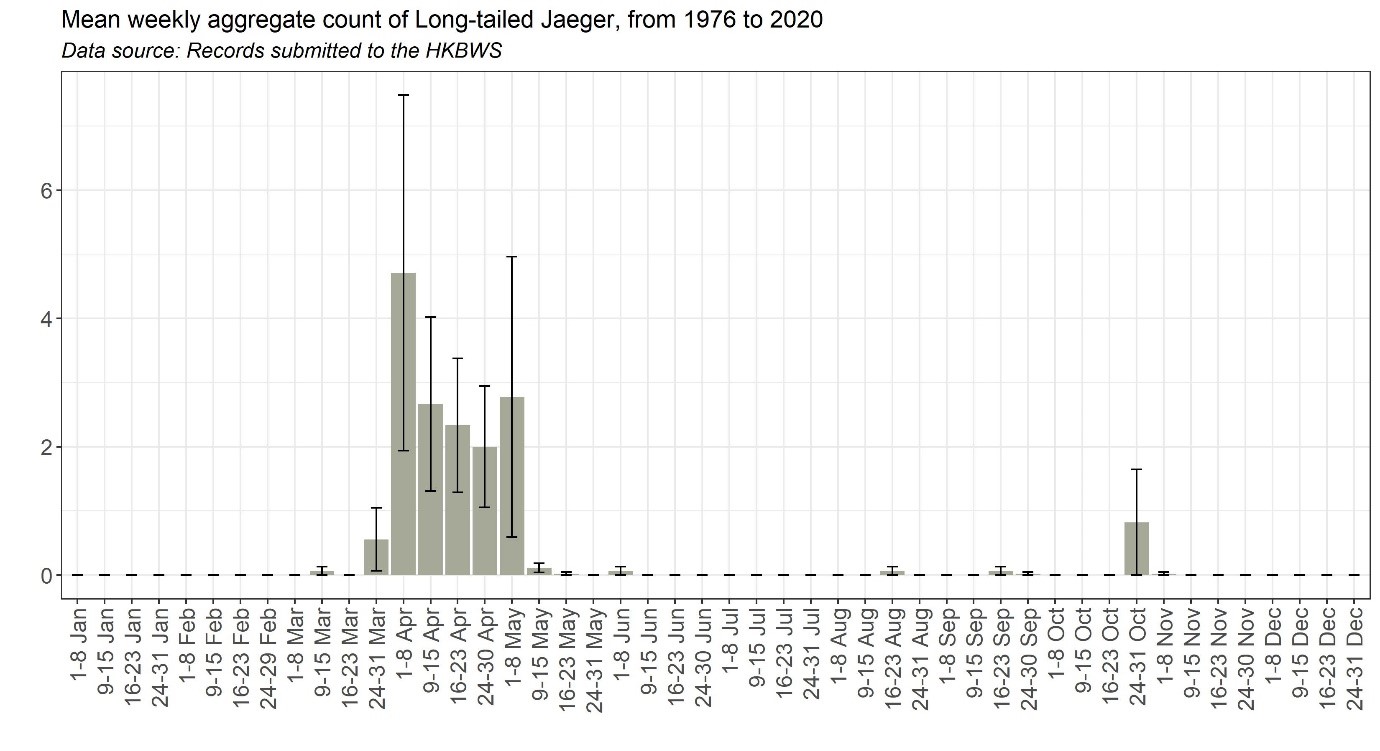Long-tailed Jaeger Stercorarius longicaudus 長尾賊鷗
Category I. Scarce passage migrant through offshore and inshore sea areas in spring; autumn records refer to storm-blown birds.
IDENTIFICATION

Apr. 2014, Martin Hale. Adult, breeding plumage.
35-41 cm (excluding tail streamers). Smaller and slimmer than other jaegers with longer more slender wings. Buoyant, tern-like flight.
Adult has very long central tail feathers nearly twice as long as tail and lacks a pale area on underside of the wings. On the upperwing the flight feathers are slightly darker than wing coverts, while the lower half of the underbody is an even greyish.

Apr. 2008, Michelle and Peter Wong. Adult, breeding plumage.
The distinct black cap, contrast between the wing coverts and remiges and the long tail feathers are visible on this bird.

Apr. 2014, Kenneth Lam. Second calendar-year.
Pale-base to bill, greyish overall coloration, pale head, darkly barred undertail coverts, clear whitish bars on underwing coverts and axillaries, central tail feather projection longer than bill and barred underwing primary coverts identify juveniles. For detail on immature plumages see Olsen and Larsson (1997).
VOCALISATIONS
Not reported to call in HK, but flight calls on the breeding grounds are ‘krek’ or ‘kloo’.
DISTRIBUTION & HABITAT PREFERENCE
Long-tailed Jaeger is the only skua that has been recorded away from offshore waters in significant numbers. There are records from Mai Po and a number of records from Mirs Bay. The latter occurred in the 1990s when observations in offshore waters to the south of HK only occurred from Cape D’Aguilar during tropical storms. In more recent years boat-based surveys have revealed that it passes offshore regularly.
OCCURRENCE
The first record for Hong Kong was of an adult at Mai Po on 9 May 1976 (Viney 1978), which was followed by an adult at High Island Reservoir on 19 May 1991. Long-tailed Jaeger is a scarce migrant mainly in spring through offshore waters to the south and east of Hong Kong.
The earliest in spring occurred on 12 March 2006, but records in that month are rare. Main spring passage occurs in April and the first week of May, with the two latest records occurring on 19 May 1991 and 3 June 2012.
Autumn records are much rarer and have all occurred during or in the wake of the passage of a tropical storm. These have concerned adults at Cape D’Aguilar during tropical storms in 1993 (three on 21 August, one on 26 September and one on 5 November) and 1998 (37 on 26 October), and three at Mai Po NR on 23 September 2013.
BEHAVIOUR, FORAGING & DIET
Compared to its congeners, Long-tailed Jaegers are more likely to be encountered in HK in flocks many of which are first noticed resting on the sea.
RANGE & SYSTEMATICS
Almost circumpolar breeding distribution in Arctic tundra, excluding only much of Greenland; winters largely at sea in the southern oceans (Wiley and Lee 2020). In China a migrant through most sea areas (Liu and Chen 2020).
The nominate subspecies breeds from north Scandinavia east through north Russia to the Lena River, while S. l. pallescens, which is presumed to occur in HK, breeds to the east through Siberia and Kamchatka to Alaska and high Arctic Canada.
CONSERVATION STATUS
IUCN: Least Concern. Population trend stable.
Figure 1.

Liu, Y. and Y. H. Chen (eds) (2020). The CNG Field Guide to the Birds of China (in Chinese). Hunan Science and Technology Publication House, Changsha.
Olsen, K. M. and H. Larsson (1997). Skuas and Jaegers. A Guide to the Skuas and Jaegers of the World. Pica Press, Sussex.
Viney, C. A. (1978). Report on the birds 1976. Hong Kong Bird Report 1976: 7-44.
Wiley, R. H. and D. S. Lee (2020). Long-tailed Jaeger (Stercorarius longicaudus), version 1.0. In Birds of the World (S. M. Billerman, Editor). Cornell Lab of Ornithology, Ithaca, NY, USA. https://doi.org/10.2173/bow.lotjae.01

